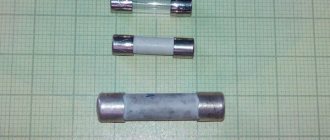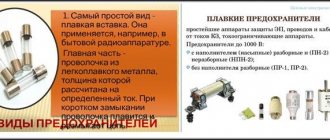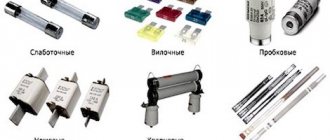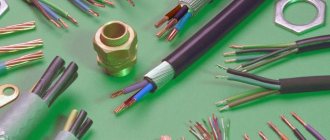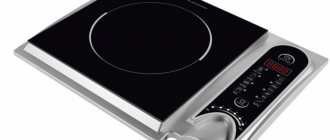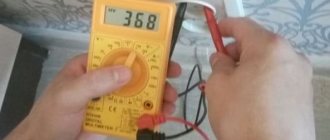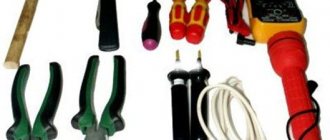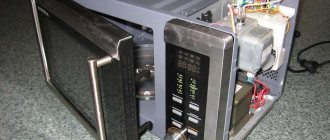In modern electrical appliances, fuses are found everywhere, or, to put it scientifically, fuses.
They protect the network and the device itself from short circuits or overload. The design of fuse links is very diverse, as are the sizes. The rated currents and voltages for which fuses are issued correspond to standard values. Its overall dimensions, namely length, depend on the rated voltage of the fuse; the higher the rated voltage of the fuse, the greater the distance between the contacts. The rated current is determined by the cross-section of the wire inside the fuse. Although self-resetting electrical fuses can now be found in more expensive devices, most devices are still equipped with conventional fuses.
General concepts, introduction to tubular fuses
The most common fuses are the so-called tubular ones. They are a ceramic or glass tube with metal cup contacts at the ends. These cups are connected to each other by wire, the cross-section of which, as already mentioned, determines the rated current of the fuse. This current is indicated on the tube or one of the contact parts of the fuse. For example: F0.5A - this means that this fuse is rated for a current of 0.5 amperes.
On electrical circuit diagrams, a fuse is indicated by a rectangle with a straight line passing through it. Next to the conventional graphic designation its position designation is indicated, for example F1 (F – fuse, fuse in English); and if this does not clutter the circuit - the rated current, for example 100 mA.
Main reasons
Each fuse is responsible for the stable operation of certain electrical circuits. If the low-melting element melts, then some kind of malfunction has occurred. Sometimes such situations are isolated, that is, after replacing the fuse, the problem does not recur. But often it turns into a trend.
Experts identify several main reasons why protective fuses burn in a car. If you understand the reason and find the source of the trouble, you will be able to return the machine to normal operation.
- bad connection. It is possible that during installation or during operation on uneven roads, the quality of contact between the fuse and the block was impaired. Sometimes it’s all about the quality of the products themselves, which are not able to guarantee a tight connection. In this situation, the best solution would be to purchase higher quality security elements,
- wear. There is a fairly widespread opinion that the first time the load on the fuse is exceeded, it immediately fails. This is not entirely true. When the situation is critical and the load is really huge, the fuse element is immediately destroyed to break the circuit. But when the load is only slightly higher than normal, the fusible component gradually fails. The cross section decreases, and as a result, after several load sessions it finally burns out. Since fuses are consumables, they tend to fail without causing serious problems in the car itself,
- wrong choice at face value. Each fuse has its own rating. This is the current strength that he is able to pass through himself. If an element with an incorrect value is installed, it cannot withstand the load acting on it and quickly fails,
- sudden surges in voltage. If a sharp surge occurs in the electrical circuit for which the fuse is responsible, the element melts and fails,
- disturbances in the current path. Each fuse is designed for a specific load and is installed on the electrical circuit corresponding to its rating. If you shorten the length of the circuit, the resistance will decrease, and the fuse will pass a higher current through itself. On modern cars, electronics are not designed to withstand overloads. Therefore, special sensitive protective elements are installed in their electrical circuits. Under critical loads, they melt and break the circuit, thereby protecting the equipment from breakdowns.
When devices and components that depend on electricity fail in a car, it is recommended to first check the condition of the fuses before repairing or replacing them. They could simply burn out, causing the systems to stop working. A simple replacement of the element will restore functionality.
Description of the operating principle of a fuse link (fuse)
The principle of operation of the fuse is extremely simple. When a rated current flows through the wire connecting the fuse contacts, this wire heats up to a temperature of about 70 °C. But when the current is exceeded, the wire heats up more, and when the melting temperature is exceeded, it melts, i.e. burns out. It is for this reason that fuses are also called fuses or fusible links. The higher the current, the faster the heating, the faster the melting occurs, and, accordingly, the fuse blows.
Thus, all fuse links operate on the same principle - excess current in the circuit causes overheating and melting of the wire inside the fuse and, as a result, disconnection of this circuit from the power source.
There are two main reasons for the burnout of fuse links: surges in the supply voltage and a malfunction within the electrical appliance itself.
Don't have a spare?
Some car manufacturers do not produce spare fuses or even leave space under the dashboard to store them. Even if you have spares in your fuse box, chances are there are only a couple of them and not of all sizes.
This holder collapsed after the clamp burned out.
Go to an auto parts store and buy a set of fuses. For less than 300 rubles you will purchase a box containing an assortment of fuses and pliers for them. Keep them dry and clean in your glove compartment.
Checking the fuse, fuse fault indicator
You can check the fuse-link with any continuity tester or tester. The goal is to ensure that the fuse circuit is intact and capable of conducting electrical current.
To avoid electric shock, checking the fuse is only allowed when the electrical appliance is turned off!
In addition, you can buy or make your own fuse blown indicator, which will notify you that the fuse has blown.
The circuit diagram of such a device is extremely simple and is shown in the following figure.
LED HL1 is connected in parallel to the fuse contacts, through current-limiting resistor R1 and diode VD1, to protect against reverse voltage. Diode VD1 must be selected based on the reverse voltage exceeding the mains voltage. For a 220 V network, the reverse voltage for the VD1 diode must be at least 300 V; for example, the 1N4004 diode or the domestic KD109B meets these requirements.
The indicator does not light if the fuse is good, and lights up if it is blown.
The indicator does not light if the load is disconnected.
This circuit is very convenient to complement home-made power supplies.
By slightly changing (simplifying) the circuit, you can get a fuse blown indicator on a neon lamp, although it does not look as effective as an LED.
VAZ 2106 fuses
Every car is equipped with various electrical appliances. The power circuit of each of them is protected by a special element - a fuse. Structurally, the part is made of a body and a fusible element. If the current passing through the fuse-link exceeds the calculated rating, it is destroyed. This breaks the electrical circuit and prevents overheating of the electrical wiring and spontaneous combustion of the car.
From the factory, cylindrical fusible links are installed in the VAZ 2106 fuse box
Selection of fuse according to the rated power of the electrical appliance
After checking the fuse and determining that it has failed, it must be replaced. And to do this, you need to find out its denomination in order to make the correct replacement.
If you know the power consumed by an electrical appliance, it is usually indicated on the nameplate of the device, you can independently calculate the rated current of the fuse using the following formula:
Inom = Pmax / Unom
The rated current (Ampere) is equal to the quotient of the maximum power (Watt) of the electrical appliance divided by the rated network voltage (Volt).
For example, a fuse in a TV has blown, it is not possible to make out what is indicated on the fuse body, its rating, but the power consumption of 150 VA is indicated on the TV nameplate.
150 / 220 = 0.68, rounded to the nearest higher standard value - 1 A.
Please note that when calculating the fuse current rating you are getting an exact current value which may not correspond to a range of fuse ratings. Therefore, the calculated value taking into account the 5% margin is rounded to the nearest standard value.
For simplicity, you can use a ready-made table that shows the ratings of standard fuses for various consumers based on their connection to a 220 V household network.
| Electrical appliance power, W (BA) | 10 | 50 | 100 | 150 | 250 | 500 | 800 | 1000 | 1200 |
| Fuse rating, A | 0,1 | 0,25 | 0,5 | 1,0 | 2,0 | 3,0 | 4,0 | 5,0 | 6,0 |
| Electrical appliance power, W (BA) | 1600 | 2000 | 2500 | 3000 | 4000 | 6000 | 8000 | 10000 |
| Fuse rating, A | 8,0 | 10,0 | 12,0 | 15,0 | 20,0 | 30,0 | 40,0 | 50,0 |
Design and principle of operation of the fuse
At the moment, there is a wide variety of shapes, ratings and sizes of such fuses, but their design and principle of operation are approximately the same. Only self-resetting fuses stand apart, but we will consider them in our article.
Operating principle of fuses
Let's start our conversation with the principle of operation of fuses. This will make it easier to understand the design and testing methods of these switching devices. Well, of course, their repair.
Joule-Lenz law
- If you remember your school physics course, you should know that when current flows through any conductor, the latter heats up. How much it heats up depends on the material of the conductor, the current strength and the cross-section of the conductor. There are many more small factors, but at this stage we will discard them.
- So, if a current of 13A is passed through a wire with a cross-section of 1 mm2, the conductor will heat up, but only slightly. If the same current is passed through a wire with a cross-section of 0.5 mm2, the conductor will heat up approximately twice as much. And if you compare copper and aluminum conductors, the latter will heat up even more - as in the video.
When heated, the conductor gives off some of the heat to the environment
- As we again remember from the school physics course, the more a conductor heats up, the worse it conducts electric current. That is, its resistance increases - and since the resistance increases, but the current remains the same, it will heat up even faster.
- It turns out that if you take two identical conductors, one with a temperature of +20⁰C, and the second with a temperature of +60⁰C, and pass the same current through them, then the second conductor will release a large amount of heat in the same period of time. These properties are the basis for the operation of fuses.
Dependence of insert heating on its material
- Essentially, a fuse is a piece of conductor with a strictly calculated cross-section. When a current flows through it below the maximum permissible, it heats up, but does not reach the temperatures at which melting of this material occurs. After all, the greater the temperature difference between the conductor and the surrounding atmosphere, the faster it cools.
Fuse operation
- If the current exceeds a certain value, then this conductor is heated to a temperature at which it melts. As a result, it collapses, thereby breaking the chain. And since there is no circuit, then there is no current. That's it, the fuse fulfilled its function, protecting our circuit from too high currents. Bring a new defender.
Fuse design
To answer the question: “Fuse - how to check?”, you need to know its design. These switching devices come in several types - tubular, blade and self-healing.
Tubular fuses are the most widespread. Knife ones are used much less frequently and mainly in the automotive industry. Self-healing ones are usually used in low-voltage electrical engineering.
Fuse design
- A tubular fuse consists of a body – usually a tube, which is why it got its name. It is usually made of dielectric materials - glass, ceramics or other dielectrics.
Note! You may find rectangular shaped tubular fuses. This does not change the essence of the issue; they are still classified as tubular.
Tubular fuse
- The beginning and end of such fuses usually have a contact part. It may simply be a seal made of conductive material. Or maybe an ending with a contact part.
PPN series fuses
- The ending can be collapsible, or it can be non-removable. It depends on the design. But usually fuses for low rated currents are made non-removable. It is believed that the cost of completely replacing such a fuse is lower than the labor costs to repair it.
- For fuses with a higher rated current - from 20A, the termination is usually made removable for possible replacement of the fuse link. Typically these are threaded connections.
- There is a fuse-link inside the housing. This can be an ordinary piece of wire of a certain cross-section. Or maybe a special insert. A piece of wire is usually found in fuses with a small current rating. Usually it is soldered to the end, or attached using crimping.
Fuse design with removable fuse link
- Special inserts are attached to the fuse end, sometimes using special clamps, but most often using conventional bolted connections.
- The internal cavity of the body may be hollow, or may contain a special filler. The purpose of such a filler is to extinguish the arc that may occur when the fuse link burns out. Quartz sand is usually used as a filler.
Blade fuse
- As for blade fuses, they usually have a plastic body and two blade contacts. This is where the name came from. A fuse-link is attached to these contacts by soldering.
Replacing the fuse
When replacing a fuse, to avoid electric shock, be sure to unplug the electrical appliance!
There is an unspoken rule: if after the second replacement the fuse blows again, look for a fault in the electrical appliance itself. This means that the electrical appliance needs to be repaired.
Do not install a fuse at a higher current under any circumstances; such attempts will definitely lead to even greater damage to the device, up to the point of its being beyond repair!
Be careful when purchasing a new fuse. Correctly determine the type and current rating of the replacement candidate. It is better to purchase electronic components from trusted suppliers who guarantee product quality, such as Conrad Electronic. The full range of fuses can be found at the link - https://conrad.ru/catalog/predohraniteli_s_plavkoy_vstavkoy.
Basic information about fuses
Let's start with the basics. Any electrical component uses a certain amount of energy to perform its task. Take, for example, a 21-watt incandescent brake light bulb. Two such lamps consume 42 watts. At your vehicle's rated operating voltage of 14 volts, that works out to about 3 amps of electrical current. Let's assume that the wires going to the lamp socket are frayed and the exposed wire touches some metal surface, shorting the electrical circuit to ground. The current consumption can suddenly increase by tens of amperes - and in a few seconds the wiring harness will turn into smoking, charred ruins - if not for the fuse. A fuse is designed to pass a certain amount of current and no more. Try to force it to let more through, and the small wire or strip of metal inside it will melt quickly, preserving the rest of the wire. And then you can find the short circuit, fix it and replace the fuse for a few rubles.
Use a voltmeter or test light to determine if there are any blown fuses, so you don't have to pull them out and inspect them one by one.
Fuses sometimes seem to fail out of the blue. Go figure it out. One common scenario is when a lamp or headlight burns out. The melting filament in a lamp can momentarily short out the contacts inside the lamp as it evaporates, absorbing enough current to blow the fuse. You will have to replace both the lamp and the fuse.
Fuse repair
Typical people believe that fuses cannot be repaired; in fact, this is not the case. Most types of fuses can be repaired and given a second, third, etc. life. The fuse housing, as a rule, is destroyed extremely rarely, the wire inside burns out, and the repair consists of replacing it. The main task is to use a wire similar to the one in the fuse.
If you need to replace a fuse very quickly, but you don’t have a spare at hand, you can use the following method:
Remove the paint coating from a wire of a suitable diameter (clean it until it shines) and wind several turns around each fuse contact, then insert the fuse into the holder. This method is popularly called “bug”. With its help you can very quickly check the serviceability of the device, but it is not reliable and can be used as a temporary solution to the problem.
The next method is the so-called “factory” one. Repairs will require a soldering iron, and perhaps a Dremel or screwdriver, but the fuse after repair will look like it came straight from the factory.
Heat the ends of the cup contacts with a soldering iron and remove the solder from the holes in the ends using a toothpick or something similar. It happens that the holes are too small or completely absent, then you will have to drill them. Use a drill of small diameter 1 - 2 mm.
Pass a wire of a suitable diameter through the holes and solder it to the cup contacts.
The fuse is ready!
Causes of blown fuses
Let's start with the most important thing - the reasons for blown fuses. After all, nothing just happens, and before installing a bug, you need to determine the reasons for the fuse failure.
There may be several of them:
| The most common and common cause of a blown fuse is a short circuit. As a result of this event, the current increases sharply, to which the fuse link in the fuse reacts, burning out. |
| It is also quite common for a conductor to burn out when the drive mechanism of the supply circuit becomes jammed. In this case, the fuse acts as overload protection. |
| The next possible reason that you need to look for a wire for a fuse could be a voltage surge. With a sharp and, most importantly, long-term decrease in voltage, the current, according to Ohm's law, increases proportionally. This may cause the fuse to blow. With short-term jumps, this happens extremely rarely. |
| Another possible option is the frequent operation of the fuse on the verge of tripping. When the current flowing through it is close to the rated current, the fuse wire becomes very hot. Then it cools down and heats up again. This mode changes the structure of the metal, which is why the fuse can blow at significantly lower current values. |
| It is to eliminate such cases that high-quality fuses are made from the purest possible metals. Their structure changes due to frequent temperature changes are minimized. |
Selecting the diameter of the fuse wire
As written above, to repair a fuse, it is necessary to replace the burnt wire with one similar to the one that was in the fuse before it burned out.
Factory fuses use wires made of various metals: silver, copper, aluminum, tin, lead, nickel, etc. At home, it is unlikely that we will be able to determine the material of the wire of a blown fuse, and we also have ordinary copper wire at hand. But just in case, we present a table of wire diameters depending on the rated current of the fuse, containing, in addition to copper, aluminum, steel and tin.
| Fuse current, A | 0,25 | 0,5 | 1,0 | 2,0 | 3,0 | 5,0 | 7,0 | 10,0 | |
| Wire diameter, mm | Copper | 0,02 | 0,03 | 0,05 | 0,09 | 0,11 | 0,16 | 0,20 | 0,25 |
| Aluminum | — | — | 0,07 | 0,10 | 0,14 | 0,19 | 0,25 | 0,30 | |
| Iron | — | — | 0,13 | 0,20 | 0,25 | 0,35 | 0,45 | 0,55 | |
| Tin | — | — | 0,18 | 0,28 | 0,38 | 0,53 | 0,66 | 0,85 | |
| Fuse current, A | 15,0 | 20,0 | 25,0 | 30,0 | 35,0 | 40,0 | 45,0 | 50,0 | |
| Wire diameter, mm | Copper | 0,33 | 0,40 | 0,46 | 0,52 | 0,58 | 0,63 | 0,68 | 0,73 |
| Aluminum | 0,40 | 0,48 | 0,56 | 0,64 | 0,70 | 0,77 | 0,83 | 0,89 | |
| Iron | 0,72 | 0,87 | 1,00 | 1,15 | 1,26 | 1,38 | 1,50 | 1,60 | |
| Tin | 1,02 | 1,33 | 1,56 | 1,77 | 1,95 | 2,14 | 2,30 | 2,45 | |
Algorithm for working with a microwave oven
Most modern microwaves do not have high-voltage fuses, so the mains protector takes over the responsibility. But it burns out only if the transformer receives double load. In the event of a breakdown, you must perform the following actions:
- Disconnect the product from the network.
- Open the top cover; expose the body of the high-voltage device and check that everything is intact.
- If the filament burns, remove the fuse from the housing, check the contacts for burning, clean them, insert a new element with the same parameters.
For those users who are new to the oven, additional recommendations are needed. To remove the top cover without any problems, you first need to find all the fasteners and carefully remove them from their sockets. During a visual inspection, you can use a magnifying glass to accurately determine the presence of a thread, and also clearly see the markings on all elements. A new fuse must be purchased with a blown one, so that they are identical, otherwise the thread may burn out immediately after switching on.
Calculation of fuse wire diameter
If you need a fuse for a current not listed in the table above, you can use the formula to calculate the diameter of the copper wire depending on the rated current of the fuse.
For low currents (using thin wire with a diameter of 0.02 to 0.2 mm), the formula is as follows:
d = Ipl k + 0.005
For high currents (when using wire with a diameter of more than 0.2 mm), the formula is as follows:
Where Ipl is the fuse-link current in amperes, k and m coefficients, depending on the conductor material, can be determined from the following table.
| Wire material | Odds | |
| k | m | |
| Copper | 0,034 | 80 |
| Aluminum | — | 59,2 |
| Iron | 0,127 | 24,6 |
| Tin | — | 12,8 |
It's better to light one candle
Modern cars and trucks are very dependent on their electrical systems. Such a system in your car may produce more energy than was once available in your great-great-grandfather's house. You may find three different fuse boxes on your vehicle and several dozen fuses. Unlike home electrical panels, which rely on resettable, reusable circuit breakers, most automotive electrical circuits use resettable fuses that can only be used once.
Reviews from car enthusiasts
In the summer of 2022, during a trip to the Krasnodar region in my Audi, I discovered that the light bulbs in the cabin did not work, the cigarette lighter had failed and something else, I don’t remember. I took out the fuses: one burned out - mini. I also bought “norma” just in case. Changed it and everything worked. I traveled halfway through the region with them, then went to visit my parents in Berdyansk, and then to my native Pskov. The AutoStandart Premium “norma” fuses turned out to be of high quality. By the way, they are produced in Pskov. I recommend.
Oleg, Pskov.
Recently my friend's headlight fuse failed in his Honda Accord. He immediately changed it from a domestic set. A little later, a bunch of wires that lead to this headlight are burning. The cause was a short circuit in the lamp. The real reason turned out to be a defense mechanism. At work from a power source I tested everything one by one. One 35A-4OA began to heat up, and the plastic case began to melt. And the jumper, which is made of the same material as the fuse legs, is not even red. Be careful, this little thing could cause your car to catch fire.
Evgeny, Kilmez.
The problem of protecting your car, I think, worries all car enthusiasts.
If the fuses are blown, this does not mean that they are at fault. They simply do their job: protect the wiring from fire. I have a fuse box on my car. I use them like AutoStandart Premium “norma” 106204, and I like them - I always buy them. They fit tightly into the sockets, so contact with the car is not lost. If the fuses are blown, it means something is wrong with the car, and you have to look for a breakdown. Vyacheslav, Nizhny Novgorod.
